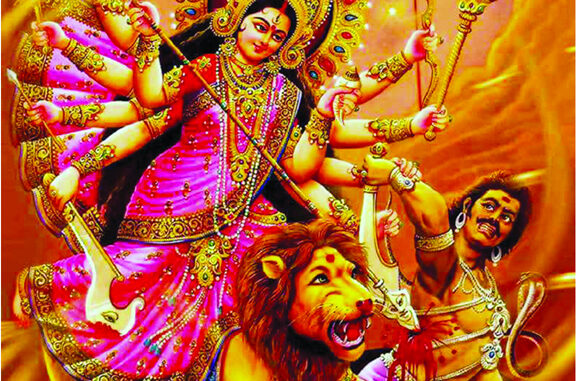
Navratri is one of the holiest Hindu festivals. Navratri is the festival of Goddess Durga who is the most powerful female god of Hindu mythology. Navratri is celebrated for nine nights during which people worship Goddess Durga and Her nine forms to seek Her blessings to remove of miseries of life . Goddess Durga blesses Her devotees with Her Love, protection, fearlessness, courage and confidence and many other divine blessings. According to the Hindu calendar, Navratri starts at the first day of the bright fortnight of Ashwin. The nine days have great religious significance as Goddess Durga, the divine mother, killed demon Mahishasura during this period.
Nine days, nine indulgence
- On the first day devotees can offer pure ghee made from cow milk. This will relieve the devotees from all the diseases.
- On the second day, devotees should offer sugar to the Goddess. This will increase the life span of the devotees.
- On the third day, devotees can offer milk or the sweet kheer made from milk. This will relieve the devotees of all their sorrows and sufferings.
- On the forth day, Malpua, This will help in the brain development of the devotees and increases the discreation power of the devotees.
- On the fifth day, Bananas. This keeps the body healthy.
- On the sixth day,Honey. This makes people attract towards the devotees.
- On the Seventh day, Jaggery. This protects the devotees from the sudden misfortunes.
- On the eighth day, devotees can offer Coconut to the Goddess. This relives the devotees from all the sufferings related to their children.
- On the ninth day, devotees can offer Til or seasame seeds to the Goddess. This takes away the fear of death.
Legend associated with Navratri
Hindus commemorate the goddess Durga’s victory over the monster Mahishasura during the festival of Navratri. Because of Mahishasura’s devotion to him, Lord Brahma had granted Mahishasura the gift of immortality, ensuring that he would never die. The only individual who would be able to take down Mahishasura would be a woman, hence this gift did have one restriction. Mahishasura was pleased with the bargain because he didn’t believe any woman could kill him. No god was able to stop Mahishasura and his soldiers as they became stronger and began assaulting people on Earth. Finally, the three most potent Hindu gods—Lord Brahma, Lord Vishnu, and Lord Shiva—decided to unite and manifest the goddess Durga, a formidable woman whose mission would be to kill Mahishasura. Before fighting Mahishasura, the gods gave the goddess Durga a plethora of weapons. For ten days, Durga battled the demon, but it was challenging since he kept changing his appearance to trick the goddess. But when he at last transformed into a buffalo, Durga was able to triumph over him.
Significance of Navratri
Navratri is Hindi for “nine nights.” Nine and night are represented by the words “Nava” and “Ratri,” respectively. Devi stands for the eternal cosmic Energy. This Energy permeates the entirety of Creation.
Navratri and the related Goddesses
The festival commemorates the epic war between Durga and the evil Mahishasura to mark the triumph of good over evil. The Navadurga, Durga’s nine avatars, are the central objective of these nine days. Every day is linked to a different goddess avatar.
Pratipada Tithi – Devi Shailaputri
This day is referred to as Pratipada (first day) and is connected to Shailaputri (“Daughter of Mountain”), a manifestation of Parvati. In this incarnation, Durga is revered as Shiva’s wife and is shown riding the bull Nandi while holding a trishula in her right hand and a lotus in her left. According to legend, Shailaputri is Mahakali’s Avatar.
Dwitiya Tithi – Devi Brahmacharini
Goddess Brahmacharini, a different form of Parvati, is worshipped on Dwitiya (the second day). Parvati took on the form of Yogini, her unmarried self. Brahmacharini is revered for bestowing moksha, or liberation, as well as stability and prosperity.
Tritya tithi – Devi Chandraghanta
The third day, or Tritiya, marks the worship of Devi Chandraghanta another incarnation of Devi Parvati. She is called Chandraghanta because she wears a crescent moon on her head.
Chaturthi Tithi – Devi Kushmanda
On Chaturthi (the fourth day), devotees worship the goddess Kushmanda. The color of the day is orange because Orange color is the color of creativity and compassion and Devi Kushmanda, who is thought to represent the universe’s creative force, is believed to have created life on earth.
Panchami Tithi – Devi Skandamata
The goddess Skandamata, who is celebrated on Panchami (the fifth day), is Kartikeya’s mother who is also known as Skanda.
Shashthi tithi – Devi Katyayini
The sixth day of the Navratri is dedicated to Devi Katyayini. She is an incarnation of Durga who was born to the sage Katyayana and is depicted as displaying the boldness that the color red represents.
Saptami Tithi – Devi Kaalaratri
On Saptami, Kalaratri, thought to be the fiercest manifestation of Goddess Durga, is worshipped. According to legend, Parvati took on the avatar of a dark-skinned goddess out of rage in order to kill the demons Sumbha and Nisumbha.
Ashtami Tithi – Devi Mahagauri
Ashtami (eighth day)of Navratri is dedicated to Devi Mahagauri. Mahagauri is a representation of wisdom and harmony. Pink, a color that symbolizes optimism, is the color linked with this day.
Navami Tithi – Devi Siddhidatri
People pray to Siddhidhatri on the Navratri’s final day, also known as Maha Navami or Navami (the ninth day). She is regarded as possessing and bestowing all Siddhis while seated on a lotus .





Be the first to comment